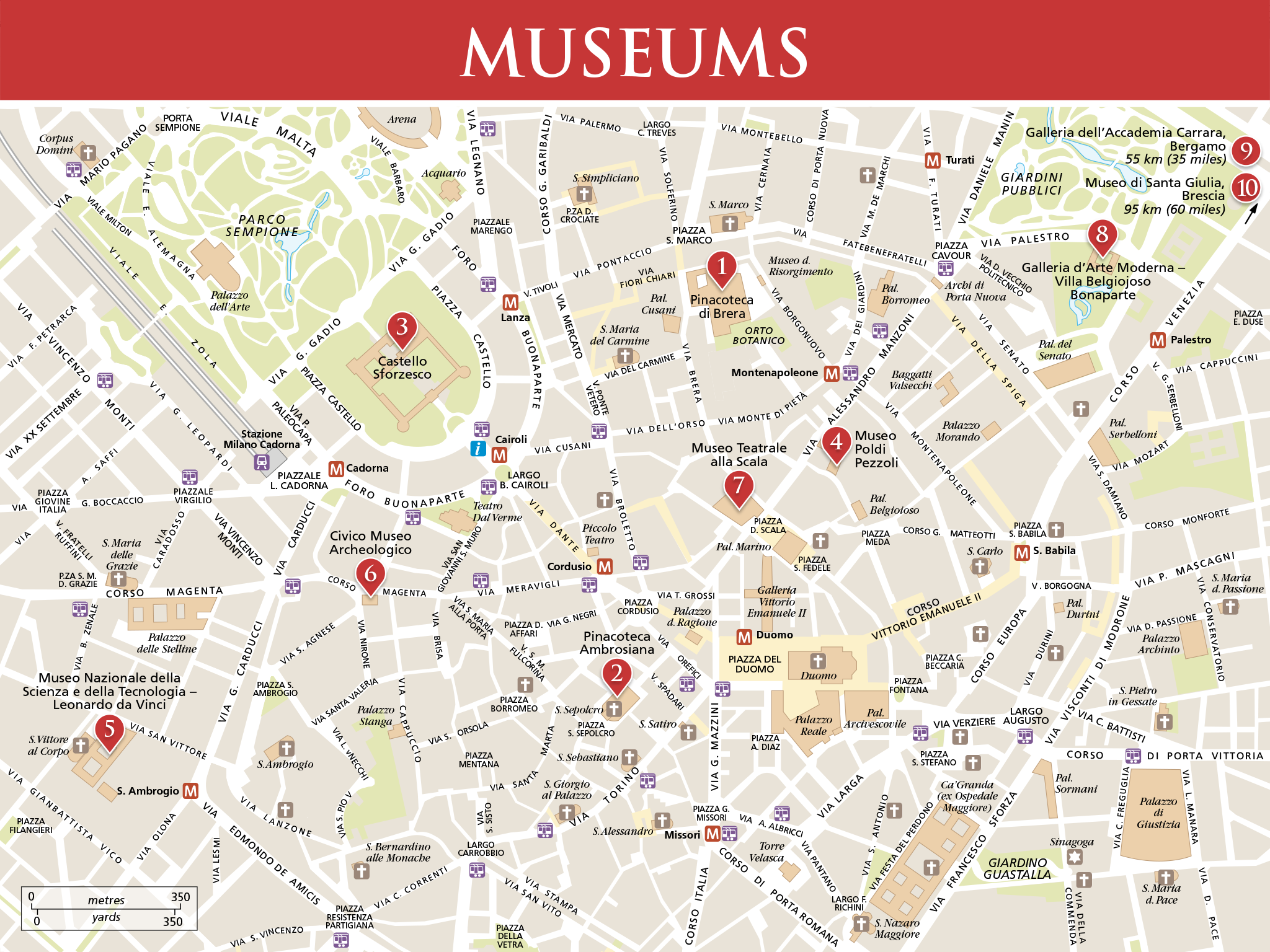
Museums
1. Pinacoteca di Brera, Milan
Lombardy’s most important painting gallery, displaying works by Mantegna, Giovanni Bellini, Piero della Francesca, Caravaggio, Tintoretto, Veronese, Correggio, Lotto, Carpaccio, Tiepolo, El Greco and Rembrandt (for further details see Pinacoteca di Brera).
2. Pinacoteca Ambrosiana, Milan
This formidable mix of Old Masters was started by Cardinal Federico Borromeo as an adjunct to the Ambrosiana Library. Famously, the library is home to the Codex Atlantico, which contains the lion’s share of Leonardo’s drawings and sketches – photocopied pages from it are displayed in the Pinacoteca. Elsewhere, you’ll find paintings by Botticelli, Titian and Caravaggio, as well as Raphael’ s giant preparatory sketch for the School of Athens (for further details see Pinacoteca Ambrosiana).
3. Castello Sforzesco, Milan
There’s a bit of everything here: paintings by the likes of Bellini and Mantegna, a cycle of 16th-century tapestries, archaeological collections and, its greatest piece, Michelangelo’s unfinished Rondanini Pietà (for further details see Castello Sforzesco). Entrance to the castle is free, but there is an entry fee for the Musei Civici within.
4. Museo Poldi Pezzoli, Milan
Poldi Pezzoli’s mansion is preserved as a monument to his collections, from Persian tapestries, ancient arms and armour to historic jewellery and, above all, art. In one room alone, there are paintings by Piero della Francesca, Giovanni Bellini, Mantegna and Botticelli (for further details see Museo Poldi Pezzoli).
5. Museo Nazionale della Scienza e della Tecnologia – Leonardo da Vinci, Milan
Had Leonardo possessed more technological ambition, we might have had working versions of his helicopters, water screws, Gatling guns, parachutes and siege engines over four centuries ago. As it is, we can make do with the (modern) wooden mock-ups on display at this science and technology museum, alongside instructive exhibits on physics and antique autos and aeroplanes (for further details see Museo Nazionale della Scienza e della Tecnologia – Leonardo da Vinci).
6. Civico Museo Archeologico, Milan
Among the top pieces in this small archaeological collection, which traces Lombard and neighbouring civilizations from prehistory to the end of the Roman era, is the Trivulzio Cup. This precious 4th-century glass cup has a delicate glass netting hovering just above the chalice surface on thin stilts of glass, along with a raised inscription that reads “Drink to Enjoy Long Life” (for further details see Civico Museo Archeologico).
7. Museo Teatrale alla Scala, Milan
If it has to do with the opera in Milan, it’s on display here. It’s an eclectic collection, from costumes worn by Nureyev or Callas to historic musical instruments, and from Verdi’s death mask (and some of his original scores) to Toscanini’s batons (for further details see Museo Teatrale alla Scala).
8. Galleria d’Arte Moderna – Villa Belgiojoso Bonaparte, Milan
This fine collection of art, housed in the handsome Villa Belgiojoso Bonaparte, includes Neo-Classicism and Romanticism works from the beginning of the 20th century plus the Vismara and Grassi collections. Italian 20th century works can be seen in the Museo del Novecento (for further details see Palazzo Reale).
9. Galleria dell’Accademia Carrara, Bergamo
Count Giacomo Carrara, a collector and expert on literature and art, left his collection to Bergamo, on his death in 1796. Today the gallery houses over 1,800 paintings, including works by Botticelli, Mantegna, Bellini and Raffaello. There is also a significant collection of prints and sketches, sculpture and china. Above all, though, come to admire the emotion-filled Renaissance paintings of Lorenzo Lotto, a Venetian painter who settled in Bergamo in 1513 (for further details see Galleria dell’ Accademia Carrara).
10. Museo di Santa Giulia, Brescia
Though there are Romanesque carvings and detached frescoes galore in the cloisters, chapels and chambers of this medieval monastery, the real focus here is on Brescia’s great era as a Roman colony, and the archaeological works on display are astoundingly beautiful and well preserved.

